When you purchase through links on our site, we may earn a commission. Here’s how it works.
If your furry friend has been diagnosed with diabetes, monitoring your dog’s blood glucose levels is one of the most important things you can do as a pup owner to manage this chronic disease. Dogs diagnosed with diabetes require at least one but typically two daily insulin injections. But managing insulin injections with your dog’s diet can get tricky.
Having an at-home dog glucose meter (called a glucometer) can be a crucial part of hitting the sweet spot of blood sugar levels to keep your diabetic pup as healthy as possible. For many diabetic dogs, veterinarians ultimately rely on pup owners to be diligent every day to follow strict insulin, dietary, and blood sugar monitoring needs.
At A Glance: Best Glucose Meter For Dogs
| Winner | Runner-Up | Third Place |
|---|---|---|
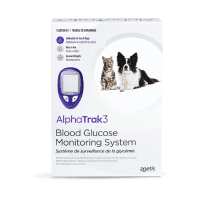 | 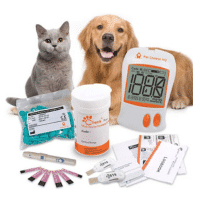 |  |
| AlphaTrak 3 | Pet Control HQ | Advocate PetTest |
| View on Amazon | View on Amazon | View on Amazon |
| Read Review | Read Review | Read Review |
- Why Is Glucose Monitoring Important For Diabetic Dogs?
- What Are The Benefits Of At-Home Glucose Monitoring Devices?
- Best Glucose Meter For Dogs
- How To Check A Dog's Blood Sugar At Home (Video)
- What Is Continuous Glucose Monitoring For Dogs?
- Can I Check My Dog's Blood Sugar With My Meter?
- Is There An At-Home Dog Diabetes Test Kit?
- Does Pet Insurance Cover Diabetes?
Why Is Glucose Monitoring Important For Diabetic Dogs?
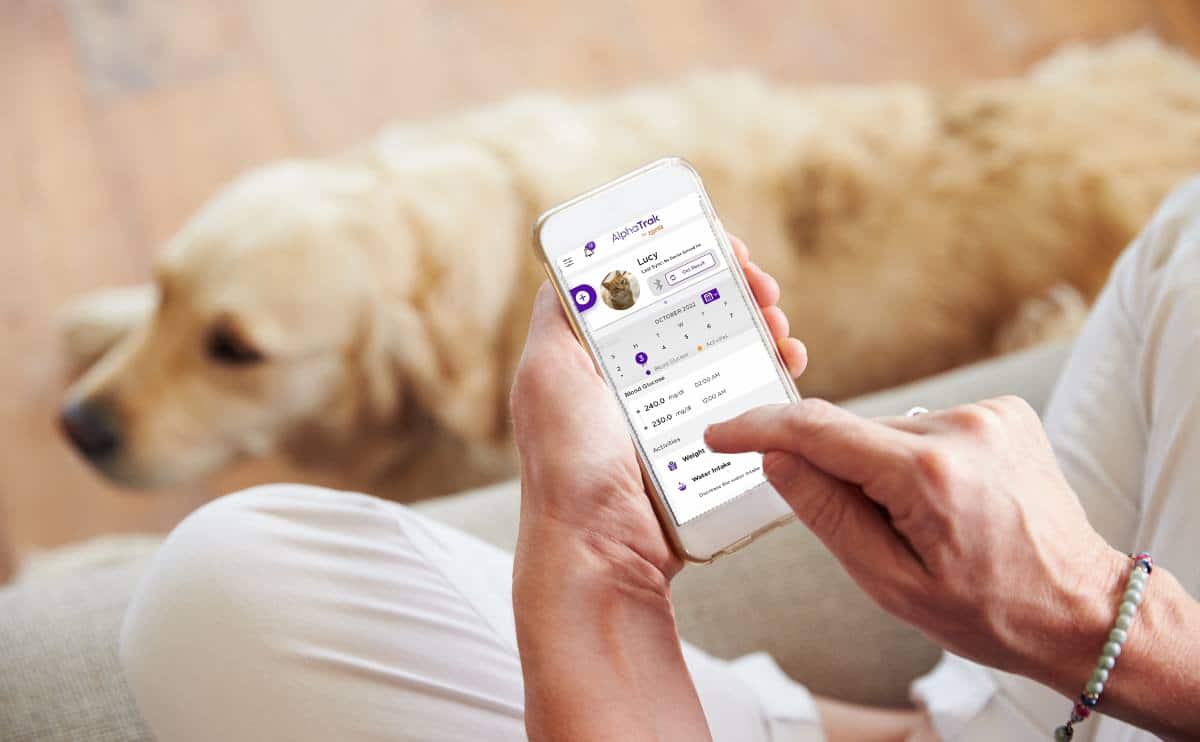
“Monitoring blood glucose in diabetic dogs is really important as it helps to stabilize diabetes as well as avoid hypoglycemic episodes,” says Dr. Hannah Godfrey, BVetMed, MRCVS, a small animal veterinarian in Cardiff, Wales. Daily monitoring is particularly crucial when your pup first starts insulin therapy. It helps your vet determine if the initial insulin dosage needs to be adjusted.
The normal blood glucose range for dogs and cats is between 80-120 mg/dL (before mealtime). For diabetic dogs, the goal is to keep blood glucose levels below 200 mg/dL and above 60 mg/dL. Very high or very low glucose levels indicate the need for insulin dosage adjustments. Once your pup’s blood sugar levels stabilize, fairly regular monitoring is still important to ensure his body is still responding properly to insulin therapy.
What Are The Benefits Of At-Home Glucose Monitoring Devices?
Compared to getting blood tests at your vet’s office, an at-home glucose monitoring system is often a lower-stress and more cost-effective way to track your pup’s blood sugar curves.
“Until recently, I performed blood glucose curve readings during practice hours, which requires pets being in the hospital for the day,” says Dr. Godfrey. “This results in pets who are naturally out of routine and often stressed, which meant their blood glucose readings were sometimes unreliable. But I have had patients where at-home blood glucose monitoring devices have been used, and this can be more reliable depending on the brand used.”
Best Glucose Meter For Dogs
We chose our top picks for the best glucometers for dogs that you can use at home based on several factors, including accuracy, ease of use, pricing, and more.
Winner: AlphaTRAK 3, 8 Piece Pet Blood Glucose Monitoring Review
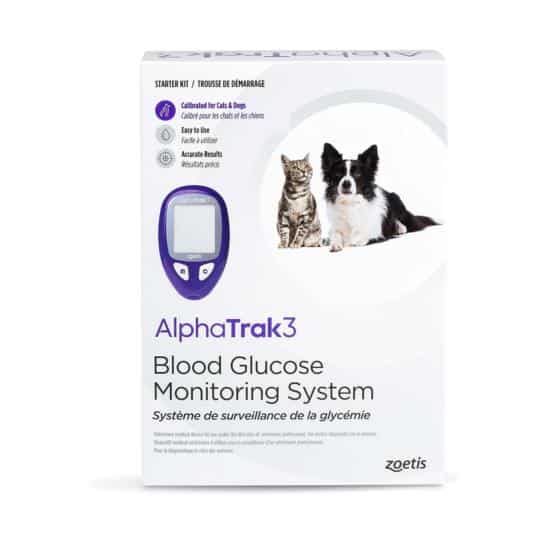
View on Amazon | View on Chewy
The AlphaTrak 3 glucometer for dogs (and cats) is the #1 vet-recommended brand to track your pup’s glucose curves. This kit includes a digital meter calibrated specifically for pets, 50 test strips, 30 lancets, a lancing device, and a control solution. The user-friendly lancing device makes it easy to collect a very small amount of blood from several locations (paw pad, marginal ear vein, elbow callus, inside of upper lip). Your vet can recommend the ideal site for your pup.
AlphaTrak gives you accurate results with an extended blood glucose testing range of 20-750 mg/dL. The meter stores previous readings, but you can also register the glucometer with the AlphaTrak mobile app to graph your furry friend’s glucose levels, share them with your vet, record daily activities, and set up notifications and reminders. It’s one of the best painless glucose monitors for dogs.
| Pros | Cons |
|---|---|
| Painless and stress-free for your pup because it only requires a very small blood sample | Users report that it’s very difficult to set up initially using the included instructions |
| #1 vet-recommended brand | Several complaints that it’s not as good as the AlphaTrak 2, which has been discontinued |
| Get results in seconds | |
| Can graph glucose levels over time by syncing with mobile app | |
| Includes 50 test strips and 30 lancets | |
| Comes with batteries and a carrying case | |
| 3-year warranty |
Price
Runner-Up: Pet Control HQ Blood Sugar Glucose Monitor System Review
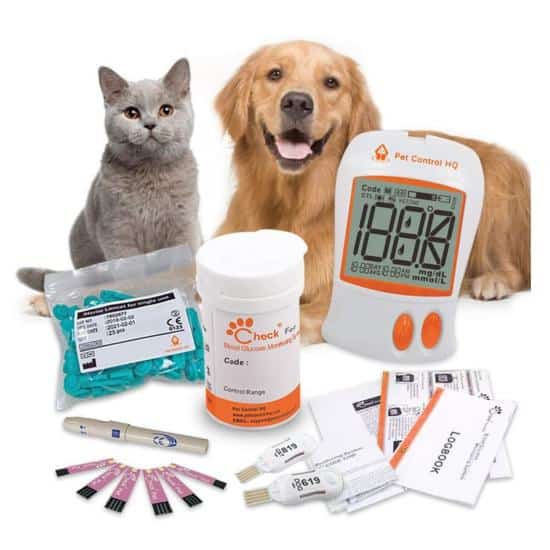
The Pet Control HQ glucometer is recommended by many vets for its track record of accuracy and ease of use. It uses GDH enzyme test strips and comes with two code chips (one calibrated for dogs and the other for cats) for more accurate results. This kit also comes with 50 test strips, 50 lancets, a lancing device, and a control solution.
It requires a small amount of blood (0.6uL). And most users say the lancing device and lancets work extremely well. This glucometer only reads blood sugar levels up to 250 mg/dL, so it won’t be able to detect if your pup’s glucose level is dangerously high. However, it has a ketone warning sign if your pet’s level is over 250 mg/dL.
| Pros | Cons |
|---|---|
| Designed for high accuracy with separate code chips for dogs and cats | Only reads blood glucose levels up to 250 mg/dL |
| Painless and stress-free lancing | A few complaints that the test strips require more blood than the Alpha Trak and Advocate systems |
| Get results in 10 seconds | |
| Includes 50 test strips and 50 lancets | |
| Comes with a carrying case | |
| 1-year warranty |
Price
Third Place: Advocate PetTest BMB-EV099X Review
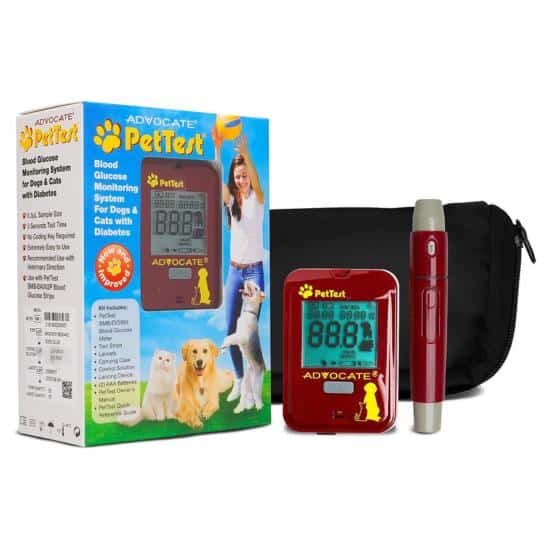
View on Amazon | View on Chewy
The Advocate PetTest glucometer for dogs and cats is a good value if you’re on a tight budget. (And the testing strips are also reasonably priced.) This starter kit includes a blood glucose meter, 25 test strips, 25 lancets, a Red Dot lancing device, and a control solution.
Like AlphaTrak 3, this is another painless glucose monitor for dogs. It only requires a very small blood sample size of 0.3uL. And it measures blood glucose levels ranging from 20 mg/dL to 600 mg/dL. We love that the meter stores over 400 test results, making it easy to track glucose curves.
| Pros | Cons |
|---|---|
| Specifically calibrated for dogs and cats | Some complaints about recurring error messages |
| Painless and stress-free lancing | Some customers say the lancing device won’t penetrate their dog’s skin |
| Get results in 5 seconds | |
| Meter stores 400+ test results | |
| Includes 25 test strips and 25 lancets | |
| Comes with batteries and a carrying case | |
| 1-year warranty |
Price
UltiCare iPet PRO Blood Glucose Monitoring System Review
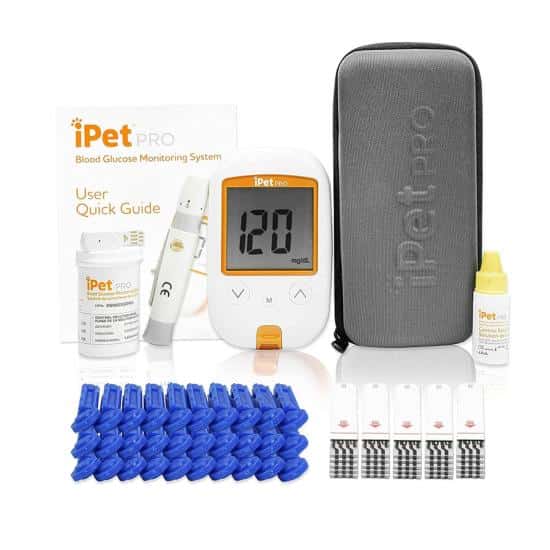
View on Amazon | View on Chewy
The iPet PRO is another kit that gives you everything you need to monitor your pup’s blood sugar at home. It includes a glucometer designed for use in dogs and cats, a lancing device, 25 test strips, 30x 28-gauge lancets, and a control solution.
It provides results up to 415 mg/dL, so its range isn’t as extensive as the AlphaTrak and PetTest. Unfortunately, we’re wary of recommending this device based on some customer reviews about inaccurate low readings that were confirmed by their vet.
| Pros | Cons |
|---|---|
| Uses advanced technology to detect and correct sources of error for improved accuracy | Several reports of inaccurate readings (measured much lower compared to in-clinic testing) |
| Get results in 5 seconds | Complaints that the lancets don’t work well, resulting in possible stress and pain |
| Meter stores up to 500 readings | Difficult initial setup |
| Includes 25 test strips and 30 lancets | |
| Comes with batteries and a carrying case |
Price
How To Check A Dog’s Blood Sugar At Home (Video)
This brief video by the American Animal Hospital Association (AAHA) gives you an excellent tutorial on everything you need to know to test your dog’s blood glucose at home.
What Is Continuous Glucose Monitoring For Dogs?
In some cases, veterinarians recommend continuous glucose monitoring, another way for pup parents and vets to work together to monitor glucose levels. This involves a small monitor that the vet implants in a dog’s skin. The system measures the blood glucose level in real time over 10 to 14 days.
Dr. Godfrey shares her practice experience with continuous glucose monitoring. “The new gold standard is continuous blood glucose monitoring, using a FreeStyle Libre or similar constant monitoring device. While these are relatively new for animals, I have managed several cases. Most recently, I fitted a blood glucose monitoring device on a diabetic Miniature Schnauzer who had been receiving insulin injections for two years. I was able to fine-tune her insulin dose, leading to a further improvement in her symptoms after several years of fluctuation and poor control.”
Can I Check My Dog’s Blood Sugar With My Meter?
Vets typically recommend using a glucometer specifically calibrated for pets. That’s because glucose is present in the blood cells in different proportions in humans and dogs. However, it is possible to use a human glucometer to measure your dog’s glucose levels. But you’ll need your vet’s assistance.
Your vet will need to run a blood glucose curve on your pup using their clinic’s glucometer and yours simultaneously. This gives you the ability to compare your device’s readings with the corresponding readings your vet found using the clinic’s glucometer. While it can be done, it’s not the quickest or most accurate way to test your furry friend’s blood sugar.
Is There An At-Home Dog Diabetes Test Kit?
If you suspect your dog may have diabetes, an at-home urine testing strip can tell you whether he has high levels of glucose or the presence of ketones in his urine. However, we recommend you also see your veterinarian. These at-home tests aren’t always 100% accurate, and your vet can run a more extensive urinalysis as well as measure blood glucose levels.
Does Pet Insurance Cover Diabetes?
Diabetes is an eligible condition for coverage through pet insurance policies as long as it isn’t considered a pre-existing condition in your pet. This means that your pup can’t have any signs or symptoms of diabetes before enrollment or during the waiting period if you wish for diabetes to be covered.
The best time to enroll in pet insurance is when your dog is still a puppy or immediately after you adopt him. This way, if your pup develops diabetes in the future, you could save thousands on ongoing vet care for this chronic condition (assuming he doesn’t already have a diagnosis).
Tagged With: Comparison, Endocrine

